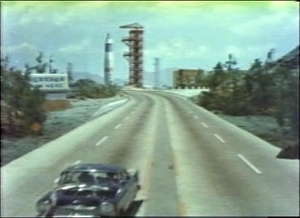 We open at a wedding as the bride and groom depart in their shark-faced car, a gleaming phallic rocket wishing them well from the background. Must be the late-1960s, and this must be Korea’s answer to Godzilla and Gamera‘s breakaway success. This is Yongary, a Sino-Korean co-production conceived with the land beyond the sea (the East Sea, that is) firmly in mind. Thus Yongary‘s many, many problems. All of which are accentuated by a horrible dubbing job and an injudicious use of TV aspect ratios.
We open at a wedding as the bride and groom depart in their shark-faced car, a gleaming phallic rocket wishing them well from the background. Must be the late-1960s, and this must be Korea’s answer to Godzilla and Gamera‘s breakaway success. This is Yongary, a Sino-Korean co-production conceived with the land beyond the sea (the East Sea, that is) firmly in mind. Thus Yongary‘s many, many problems. All of which are accentuated by a horrible dubbing job and an injudicious use of TV aspect ratios.
For now, let’s examine the families. Yongary leaves us no choice, unceremoniously dumping its audience into their after-wedding gossip session. Recounting the catty babble would be tedious, so I’ll give you the gist. We’re to understand the Happy Couple are On-na and a character I labeled Major Tom (since, in the English dub, we never learn his name). Major Tom’s friend, Ilo (present at the wedding) immediately reveals himself to be a Korean Jeff Goldblum figure twenty years ahead of his time: the dedicated-but-socially-inept Scientist who’s dating On-na’s sister, Su-na. Su-na, we soon learn, is in no hurry to marry our Scientist. Falling in love with him would apparently “be like falling in love with a computer, almost.” You can imagine Ilo thinking, Thanks, Su-na. For being made of Bitch.
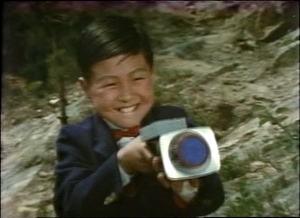 He departs ASAP. Good thing, too, for On-na’s little brother, Icho, has set upon the Happy Couple a ways down the road with (of all things) an itch-inducing ray gun. Like his Japanese counterpart’s in the Gamera films, Icho processes all the usual Kenny superpowers, complete with Access to the highest levels of the national security and (in this case) space exploration apparatus…including Ilo’s lab, where he swiped the Itch Ray. So Ilo calls the little snot into his car, and together they ride back to the lab…where Ilo suggest Icho play with a pair of toy robots. Quite a reward for theft of Super Scientific property. And attempted murder. (What if the Itch Ray drove Our Happy Couple’s car off the road, eh? Ever think of that, Itchy? No?)
He departs ASAP. Good thing, too, for On-na’s little brother, Icho, has set upon the Happy Couple a ways down the road with (of all things) an itch-inducing ray gun. Like his Japanese counterpart’s in the Gamera films, Icho processes all the usual Kenny superpowers, complete with Access to the highest levels of the national security and (in this case) space exploration apparatus…including Ilo’s lab, where he swiped the Itch Ray. So Ilo calls the little snot into his car, and together they ride back to the lab…where Ilo suggest Icho play with a pair of toy robots. Quite a reward for theft of Super Scientific property. And attempted murder. (What if the Itch Ray drove Our Happy Couple’s car off the road, eh? Ever think of that, Itchy? No?)
Cut to the Happy Couple, who’s luck never seems to change. On-na even prophesies, “Our marriage is doomed.” On-na’s dad must’ve heard her. Probably planted a bug in the “futuristic” cell phone Major Tom packed away in his suitcase…and, like any good cell phone user today, neglected to turn off before attempting to get down with the new wife. (Look out for its giant antennae, easily the film’s best unintentional joke.) “Reconnaissance job, my boy,” Major Tom’s new father-in-law informs him (and us). “The Rocket’s being ready. Seems to be some kind of nuclear test somewhere in the Middle East. We want a monitor on it. We’ll need you here within an hour.”
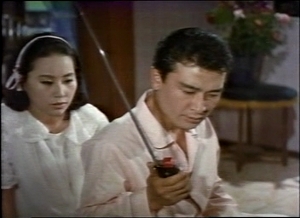 Okay. Number one: wow. The idea of a Mid-East nuclear test is a lot creeper today than in 1967. Number two: the fact that it take place in the Mid-East is probably an addition to the English edition of this film. For all I know, the nuclear test that (in true daikaiju movie fashion) triggers the rest of the plot could’ve taken place in Buluxi, Mississippi. And number three: good on this film for paying off that rocket they introduced behind the wedding party. Time for the Countdown, and the Blast-off. Time to remember that the whole world watched the Space Race, and even those who couldn’t afford to participate (for some strange reason) dreamed along with the two superpowers. And that the Korean film industry has never been able to come up with a single original idea for giant monster movie.
Okay. Number one: wow. The idea of a Mid-East nuclear test is a lot creeper today than in 1967. Number two: the fact that it take place in the Mid-East is probably an addition to the English edition of this film. For all I know, the nuclear test that (in true daikaiju movie fashion) triggers the rest of the plot could’ve taken place in Buluxi, Mississippi. And number three: good on this film for paying off that rocket they introduced behind the wedding party. Time for the Countdown, and the Blast-off. Time to remember that the whole world watched the Space Race, and even those who couldn’t afford to participate (for some strange reason) dreamed along with the two superpowers. And that the Korean film industry has never been able to come up with a single original idea for giant monster movie.
In any case, a brief moment of tension ensues when the ground-level atomic blast (somehow) cuts off all communications between Major Tom’s Gemini-esque capsule and Ground Control. Major Tom’s entire family descends on the Korean Cape Canaveral for the tense minute-and-half before channels are reopened and everything’s miraculously all-right. Dad-in-law must let the whole pack of them (including Itchy) come and go as they please, Ground Control’s own technocratic royal family. And forget Major Tom’s little brush with disaster. It’ll have nothing at all to do with the rest of the film, showcasing Yongary‘s central failing: it’s inability to follow through. At least The X From Outer Space had something to do with outer space (too much, in fact). Here, space flight is so mundane the plot discards it completely once it’s fulfilled its “ooh-ahh…space!” function.
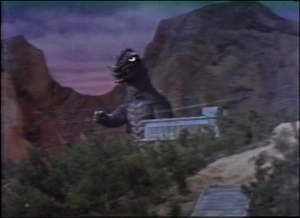 As Major Tom lands, a series of underground earthquakes begin to move towards Tokyo “the heart of Korea.” Suit-wearing officials, including Dad-in-law, spring into action…by which I mean they hold tedious meetings. In front of a map. In the English dub, eternal bon mots like, “However, I greatly fear that Science cannot help,” might shock you out of that comatose state you’ve probably slipped into by now. And just in case you missed the last one, here’s another example of Yongary sawing off its own arm: an argument (between the military and the politicians, of course) over whether or not to declare martial law is resolved (by the approaching earthquake) seconds after it’s first mentioned. No more time for tension in this man’s giant monster movie.
As Major Tom lands, a series of underground earthquakes begin to move towards Tokyo “the heart of Korea.” Suit-wearing officials, including Dad-in-law, spring into action…by which I mean they hold tedious meetings. In front of a map. In the English dub, eternal bon mots like, “However, I greatly fear that Science cannot help,” might shock you out of that comatose state you’ve probably slipped into by now. And just in case you missed the last one, here’s another example of Yongary sawing off its own arm: an argument (between the military and the politicians, of course) over whether or not to declare martial law is resolved (by the approaching earthquake) seconds after it’s first mentioned. No more time for tension in this man’s giant monster movie.
A fissure immediately opens up in the countryside and two guys in a Jeep are there. One catches a snapshot of Yongary’s dorsal fins emerging from their crack in the earth, but all seems lost when the (apparently NO2-fueled) Jeep careens over a cliff and bursts in flames. In the movie’s most outrageous moment of lunacy (plotwise, at least), the unnamed photographer is magically whisked from his wreck, right into the Tedious Meeting Room…with only a smear of stage blood down his face to show for surviving that fiery car crash. (Must’ve stopped by Darkman’s house on the way to grab some synthetic skin.)
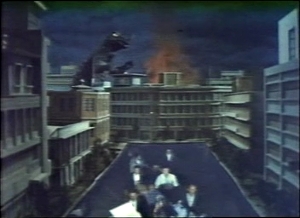 One look at the grainy photos and a military man declares, “It’s Yongary!” So Yongary it is. No one (certainly none of the Scientifically-minded characters) questions this irrational labeling. From here on, the film ceases to be an out-and-out surreal, Asiatic sci-fi pic (the only kind made in the late-60s) and passes safely into well-trod-upon daikaiju territory. Yongary emerges from a hillside and destroys some high tension towers. Official announcements are made over radios. Panicked citizens fill the streets, carrying cart-fulls of precious belongings, only to be pummeled by obviously-Styrofoam rubble (or, as Stomp Tokyo famously identified, shoe boxes painted gray to resemble bricks). Tanks mass and are duly vaporized by Yongary’s fiery breath, brought to you by the latest in nozzle-in-the-mouth technology. Callous, stereotypical youth drink and dance themselves into oblivion as, outside, Yongary trashes Seoul, raining destruction down upon the masses…who already suffer from cheap, blue screen editing techniques that allow them to hover somewhere just out of alignment with the background, as if they were projections, and all this some sort of vast, virtual reality Matrix interacting with Yongary’s so-called “mind.”
One look at the grainy photos and a military man declares, “It’s Yongary!” So Yongary it is. No one (certainly none of the Scientifically-minded characters) questions this irrational labeling. From here on, the film ceases to be an out-and-out surreal, Asiatic sci-fi pic (the only kind made in the late-60s) and passes safely into well-trod-upon daikaiju territory. Yongary emerges from a hillside and destroys some high tension towers. Official announcements are made over radios. Panicked citizens fill the streets, carrying cart-fulls of precious belongings, only to be pummeled by obviously-Styrofoam rubble (or, as Stomp Tokyo famously identified, shoe boxes painted gray to resemble bricks). Tanks mass and are duly vaporized by Yongary’s fiery breath, brought to you by the latest in nozzle-in-the-mouth technology. Callous, stereotypical youth drink and dance themselves into oblivion as, outside, Yongary trashes Seoul, raining destruction down upon the masses…who already suffer from cheap, blue screen editing techniques that allow them to hover somewhere just out of alignment with the background, as if they were projections, and all this some sort of vast, virtual reality Matrix interacting with Yongary’s so-called “mind.”
I get a strong sense of deja vu off this picture. Every frame radiates “same shit, different day,” with the uncritical resignation of a Stephen King protagonist. Those looking for a cheap Godzilla knock-off need to get reacquainted with Gamera (who is, unlike certain monsters, a friend to all children). Watching the Terrible Terrapin’s contemporaneous adventures (beginning with 1967 Gamera vs. Gaos) will give you a much better Bad Movie kick in the ass and eliminate any need to drag yourself through this. Unabashedly plagiarist, Yongary never rises of above its obvious origins as a Gamera rip-off…and considering Gamera was itself a Godzilla rip-off, Yongary becomes a perfect example of that all-too-common degenerate subspecies of film: the Rip-off Squared.
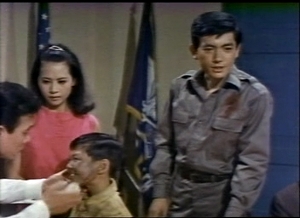 Let’s see: giant monster awakened after an nuclear bomb disturbs his subterranean rest? Check. A monster who proves invulnerable to conventional weapons, necessitating a Super Scientific Solution to his presence? Double Check. A damned-annoying kid in the shortest possible pair of shorts on Earth who, despite his complete lack of any skill unconnected to being a thieving snot, manages to survive a marathon-run through Yongary’s path of destruction unscathed and then discover the One Crucial Fact our Scientist needs to finally bring the monster down? Triple Check with a cherry on top.
Let’s see: giant monster awakened after an nuclear bomb disturbs his subterranean rest? Check. A monster who proves invulnerable to conventional weapons, necessitating a Super Scientific Solution to his presence? Double Check. A damned-annoying kid in the shortest possible pair of shorts on Earth who, despite his complete lack of any skill unconnected to being a thieving snot, manages to survive a marathon-run through Yongary’s path of destruction unscathed and then discover the One Crucial Fact our Scientist needs to finally bring the monster down? Triple Check with a cherry on top.
I’ll say this, though: you’ve gotta respect any giant monster movie that drives its Kenny into the sewers–and strands him there. It’s a far cry from the alien planets, undersea UFOs, and ancient civilizations Gamera’s youthful followers visited every other week (it seems). More realistic, really, than Itchy’s later feats. Like his working knowledge of oil refinery’s (nesessiary to discover that Yongary, like Gamera, eats flame by making the film run backwards). And his uncanny ability to emerge from the sewers without a massive staph infection. Or ten. Or fifteen. His observations obviously put Ilo on the right research track, and before you can say “Red Kryptonite” our Scientist has whipped up a batch of anti-Yongary “precipitate of ammonia.” Now, if only he could convince those hard-headed military types to let him try it out before Seoul’s wiped off the map with a barrage of ballistic missiles.
Ilo’s precipitate knocks the monster out…just long enough for Itchy to hit the creature with “his” stolen Itch Ray. This not only wakes Yongary up and gifts him with the ability to shoot cartoon lasers from his nose horn, prolonging his rampage, it also inspires him to do what so many monsters so-loved to do in this decade: boogie down.
And here is a clip of Yongary’s (in)famous dance party:
You see how silly these films really got in the late 60s. Even the most serious of them required a bit of surreal whimsy, usually condensed into the form of a Kenny. And Itcho is firmly a Kenny, possessed of off-screen teleportation powers to rival the great American Slashers of the 1980s. How else can he escape the gaze of his family and the Tedious Meeting Room’s hopefully-top-level security, steal the Itch Ray out of Ilo’s lab (again), and still make it to Yongary’s rampage site in time to wake the monster up for Act Three? (Or is it Four, at this point?)
 Basic story problems like this abound. Why wake Yongary up again at all? Besides wringing another fifteen minutes of action out of this story, this only serves to highlight what a little shit Itcho is, and how he should just up and die. The whole thing feels like the tacked-on, tedious Fourth Act, ‘cuz it is. Repetition breeds contempt, and repetitive scenes weight down this whole film. Example: do we really need to watch Ilo refine his anti-Yongary formula twice? The man shouts Scientist, and the script labels him as such from frame one. And let’s not even talk about the Tedious Meeting scenes. Their name is Legion, and Yongary certainly set a new standard of realism here: I prayed for death as fervently as ever I prayed during a “real” life tedious meeting. Splicing such scenes together with the destruction of Seoul only degrades the impact of the latter.
Basic story problems like this abound. Why wake Yongary up again at all? Besides wringing another fifteen minutes of action out of this story, this only serves to highlight what a little shit Itcho is, and how he should just up and die. The whole thing feels like the tacked-on, tedious Fourth Act, ‘cuz it is. Repetition breeds contempt, and repetitive scenes weight down this whole film. Example: do we really need to watch Ilo refine his anti-Yongary formula twice? The man shouts Scientist, and the script labels him as such from frame one. And let’s not even talk about the Tedious Meeting scenes. Their name is Legion, and Yongary certainly set a new standard of realism here: I prayed for death as fervently as ever I prayed during a “real” life tedious meeting. Splicing such scenes together with the destruction of Seoul only degrades the impact of the latter.
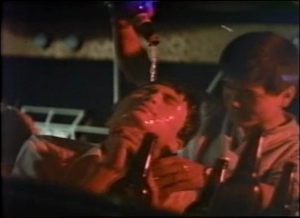 More to the point, I don’t care about any of the people, inside or out of the map-strewn meeting room. Director Ki-duck Kim and the writer of this English dub seem content to label them and move on, leaving the actors stranded in a trance-like null state. Unlike a modern film, which never slows down for characterization, Yongary slows down for all the wrong reasons, never using its slow moments to give the audience anything. Christsake – in the English dub, we don’t even learn Major Tom’s name! The actors drift through their roles with as much gravitas as they can muster…except for Icho, the audience identification character. I really can’t imagine an eleven year-old boy sitting still through all these scenes of adults arguing, but what do I know? Yongary’s backers obviously thought they knew their target audience, and rumor has it the Korean cut of the film is even longer than the American, mid-70s, TV version I screened. I say, between Major Tom’s and Ilo’s love stories (their love interests are never more than life dolls, unfortunately) and Itchy’s Great Kenny Adventure there’s barely enough movie here for an hour…or a enough for three hour epic, depending on how you juggle the mix. The stains of a no-doubt-equally Tedious series of Meetings are all over this production, with plot elements rigged in solely for their potential appeal to a targeted audience. The Great Kenny Adventure’s supposed to pull in the kids; our twin love stories, the young adults on dates; and the HO-scale destruction means to scratch that evil itch in the mind and heart of every person secretly crying out against the tenacious tyranny of a fully-administered society…the itch that screams, “smash them! Smash them ALL!”
More to the point, I don’t care about any of the people, inside or out of the map-strewn meeting room. Director Ki-duck Kim and the writer of this English dub seem content to label them and move on, leaving the actors stranded in a trance-like null state. Unlike a modern film, which never slows down for characterization, Yongary slows down for all the wrong reasons, never using its slow moments to give the audience anything. Christsake – in the English dub, we don’t even learn Major Tom’s name! The actors drift through their roles with as much gravitas as they can muster…except for Icho, the audience identification character. I really can’t imagine an eleven year-old boy sitting still through all these scenes of adults arguing, but what do I know? Yongary’s backers obviously thought they knew their target audience, and rumor has it the Korean cut of the film is even longer than the American, mid-70s, TV version I screened. I say, between Major Tom’s and Ilo’s love stories (their love interests are never more than life dolls, unfortunately) and Itchy’s Great Kenny Adventure there’s barely enough movie here for an hour…or a enough for three hour epic, depending on how you juggle the mix. The stains of a no-doubt-equally Tedious series of Meetings are all over this production, with plot elements rigged in solely for their potential appeal to a targeted audience. The Great Kenny Adventure’s supposed to pull in the kids; our twin love stories, the young adults on dates; and the HO-scale destruction means to scratch that evil itch in the mind and heart of every person secretly crying out against the tenacious tyranny of a fully-administered society…the itch that screams, “smash them! Smash them ALL!”
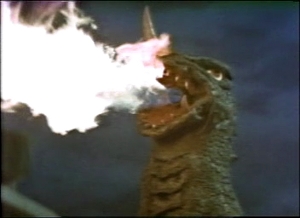 Yongary drops all of them in our laps, washes its hands and says, “There, done.” The result is a film both surreal and leaden. No other adjective can describe the maniacal laughter our human protagonists rain down upon Yongary’s corpse as the monster’s poisoned blood slowly leaks into a civic river. (Spoiler alert: in the end, the monster dies.) What are we supposed to feel about this? Does the film even know? I’m creeped right the fuck out, myself. And I don’t have to drink out of the local water table for the rest of my life…my heart goes out to these fictional Korean people and the bumper crop of defective babies they no-doubt suffered through in the wake of Yongary’s death. Kenny/Itchy even gets to express some sympathy for the monster in the end…but even this is glossed over once Itchy turns to Ilo and Su-na. He tells them to just up and get married already. Everyone laughs their patronizing, “kids-say-the-darnedest things” laughs, and Su-na (now that Ilo’s a monster-killing Heroic Scientist and all) accepts. God’s in HIs heaven, all’s right with the world. The end.
Yongary drops all of them in our laps, washes its hands and says, “There, done.” The result is a film both surreal and leaden. No other adjective can describe the maniacal laughter our human protagonists rain down upon Yongary’s corpse as the monster’s poisoned blood slowly leaks into a civic river. (Spoiler alert: in the end, the monster dies.) What are we supposed to feel about this? Does the film even know? I’m creeped right the fuck out, myself. And I don’t have to drink out of the local water table for the rest of my life…my heart goes out to these fictional Korean people and the bumper crop of defective babies they no-doubt suffered through in the wake of Yongary’s death. Kenny/Itchy even gets to express some sympathy for the monster in the end…but even this is glossed over once Itchy turns to Ilo and Su-na. He tells them to just up and get married already. Everyone laughs their patronizing, “kids-say-the-darnedest things” laughs, and Su-na (now that Ilo’s a monster-killing Heroic Scientist and all) accepts. God’s in HIs heaven, all’s right with the world. The end.
Too serious to be funny, too slow to be enjoyable, too short to be anything other than a kiddie-wink fragment of a distant time from an equally distant land, Yongary is in good company with Gorgo, Reptilicus, and the Showa Gamera series: the shopworn products of a brief international fad for giant monster pictures. This is the height of their wave, and up here the genre’s shallow, emotionally-deadened nature becomes frightfully clear. Yongary is the reason daikaiju films are derided by non-fans as disposable kid’s fare, a reputation they’ve yet to escape thanks, in part, to a lack of trying. The unfortunate fact is, Yongary got plenty of play on U.S. television stations during the 1970s and 80s. Along with Gamera and Godzilla’s sillier adventures, and something called Gappa, the Triphibian Monsters, these films created an entire new generation of giant monster fans through the constant repetition of their justly-derided silliness. Because they took themselves so seriously, we refused to take them as such. So God(zilla) help you if you’d like to take Yongary, or the daikaiju genre as a whole, seriously at all. Be prepared for the jeers and snickers.
![]()
